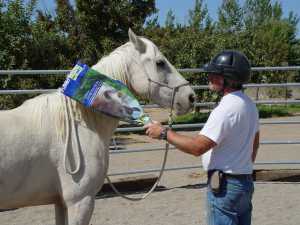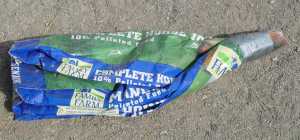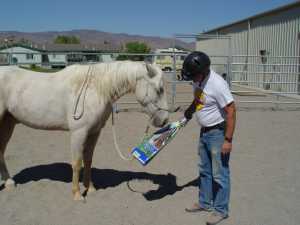Making and Using a
|

|
|
As with any horse training activities, please apply these ideas with a dose of practical common sense. We each are responsible for the results of our own actions when training large animals. The idea here is to challenge the horse, make him curios and get him to think, NOT stress him out or frighten him to death! Give the horse frequent opportunities to "find the right answer" and use lots of positive reinforcement until the horse gets used to these exercises.
The horse that appears in this feature is a formerly wild mustang undergoing the process of being gentled and trained by LRTC volunteers.
It's treacherous to handle or attempt to ride a horse that has "spooky places" on his or her body. Most horses with spooky places tend to be on guard, not only adding additional stress to the training situation but directing mental energy away from learning. Once a horse is OK with being touched all over the training and saddling process usually becomes much more safe and predictable. We often improvise using readily available supplies and materials when training horses. In fact we make most of these improvised training aids from ordinary products we pick up at the local Wal-Mart. (Please see Training Horses the Wal-Mart Way.) The aid discussed in this feature is called the "Horse Thumper," an interesting device brought to our attention by horse trainer Tony Sumner. |
|
Assembling the Thumper
We make the thumper out of two stiff paper supplement bags folded over each other, creating a handle by wrapping the tops tightly with duct tape. We've found the Manna Pro bags to be perfect, which is nice since we regularly use Manna Pro supplements and therefore have a constant supply of thumper materials. |

|
| Training with the Thumper |
|
Our first objective is to introduce the thumper to the horse. If the horse shies from the sight of the thumper, we'll walk away, leading the horse and let the horse pursue the scary object. (Horses are naturally more curious of scary things that are moving away, rather than towards them. We want the horse to learn, not merely bear the experience.)
Once the horse is no longer frightened at the sight of the thumper, we'll present it at a fairly low angle and let him smell it and investigate it, but we won't allow him to try to chew on it. (Our training aids are never to be considered by the horse to be chew toys or food.) |
Introducing the thumper
|
|
When we can move the thumper around and approach the horse without him showing fear, we'll touch down on the horse's "safe spot" (usually the shoulder with most horses.) We'll start out by "brushing" the horse with the thumper. Some horses may need a "grounding hand," or the handlers bare hand on some reassuring place on the horse so they don't inadvertently perceive the movement of the thumper as a cue to move away.
The horse should stand quietly and relaxed as the thumper is rubbed all over his body, down his back, over his head and anywhere else that it is safe to do so. |
"Touch down" on the neck
|
Continue to Part Two
|
Important Note: If you take on the project of developing an untrained horse, everybody will want to give you advice. Don't act on any advice, including the ideas offered in this site, unless it makes sense to you and fits your individual situation. Your abilities and the sensitivities of your horse(s) may differ from the examples given. Be alert and rational with your actions so neither you nor your horse will get hurt. This information is offered as illustrations of what we do and the reader must apply common sense since he or she is solely responsible for his or her actions. Happy trails!Press "Back" to return to the page that brought you hereGo to Case Study SectionReturn to Training SectionReturn to Wild Horse MentorsReturn to KBR World of Wild Horses and BurrosGo To
|

